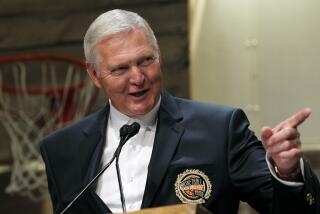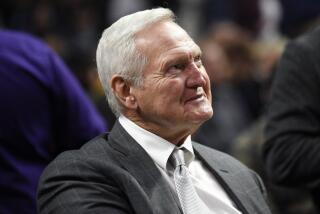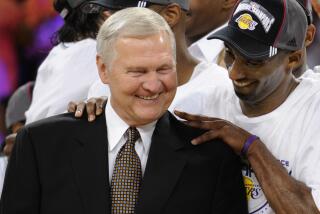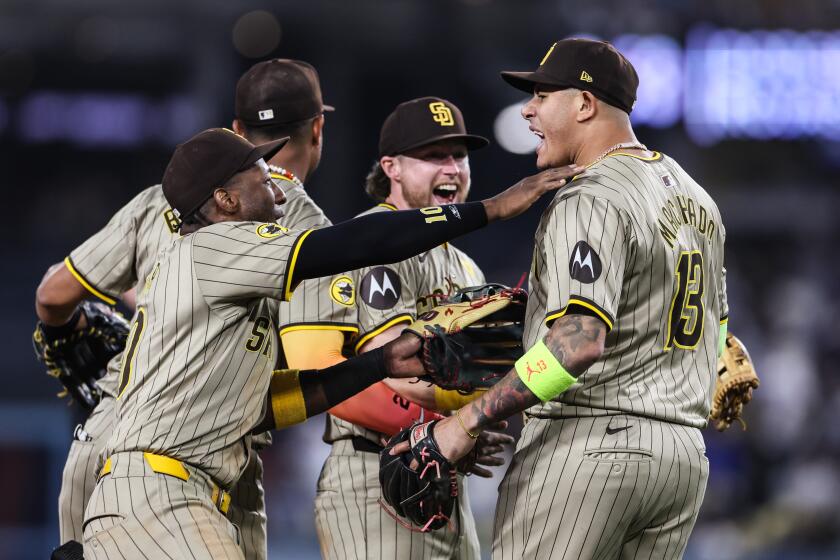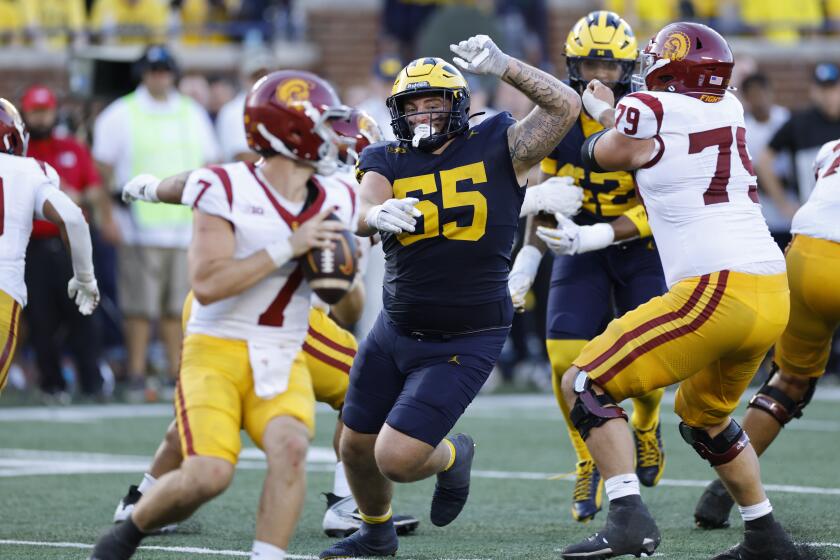The original Big Man
A three-peat obviously is a big deal, but how about a double three-peat?
As dominant as the Lakers have been in winning three consecutive NBA championships, they are only halfway toward matching the achievement of their ancestors from Minneapolis half a century ago.
The Minneapolis Lakers, coached by John Kundla, won three titles in a row, fell short the next season, then won three more NBA titles.
Six championships in seven years--two three-peats!
Those early Lakers did their winning in three leagues, though, and, completing the unlikely picture, did it in the first seven years of their existence.
The Lakers were founded in 1947 as a member of the National Basketball League, the first truly major pro basketball league, and celebrated their birth by winning the championship in the spring of ’48. The next season, they jumped to the Basketball Assn. of America, forerunner of the NBA, and won again. The NBA recognizes that as the Lakers’ first NBA title.
The season after that, the NBL and BAA were merged into the NBA, and the Lakers won again.
The streak ended in the 1951 NBA playoffs when the Lakers lost to the Rochester Royals, now the Sacramento Kings, in the Western Division finals.
Then there was another three-season run before they lost in 1955 to the Fort Wayne--now Detroit--Pistons, again in the Western Division finals.
After that, age took its toll on the Lakers and as defeats piled up, attendance fell off so sharply that the team was moved to Los Angeles in 1960.
Just as with the champion Lakers of today, the key to the team’s success was an overpowering center. The Minneapolis version of “ Superman” Shaquille O’Neal was George Mikan. His horn-rimmed glasses gave him a Clark Kent look, but he was a mighty man in his own right.
Mikan, who had played at DePaul University in Chicago, stood 6 feet 10 and weighed 245 pounds. That’s commonplace now, but he was basketball’s first dominant big man and in 1950 was voted the greatest player of the half-century.
So huge was Mikan in the basketball spectrum that when the Lakers played the Knicks in New York at the height of his career, the marquee outside Madison Square Garden read, “TONIGHT: GEORGE MIKAN VS. KNICKS.”
In an era in which a 20-point game was a rarity, Mikan averaged 16.5, 21.3, 28.3, 27.4, 28.4, 23.8, 20.6 and 18.1 over eight seasons from 1946-47 through 1953-54. He retired after that, shortly before his 30th birthday, then came back in 1955-56 for 37 games, averaging 10.5. His career average was 22.6.
Dominant as he was, Mikan was surrounded by talent. Three of his teammates--Jim Pollard, Vern Mikkelsen and Slater “Dugie” Martin--eventually joined him and Kundla in the Basketball Hall of Fame.
But Mikan was “the franchise” and when he left, the Lakers of Minneapolis ceased to be a major factor in the NBA.
Mikan, 78, who had a long career as an attorney after retiring from basketball, talked about the old days from his home in Scottsdale, Ariz.
“We had one of the best point guards in the game in Dugie Martin,” Mikan said. “He fed me for a lot of my points, and he even gave Bob Cousy a lot of trouble. Mikkelsen was our power forward, and he was a great shooter. He scored 18-20 points a game. Pollard was our small forward and one of the finest players in history. They called him ‘the Kangaroo Kid.’ He could dribble, shoot, anything. He had the whole game.”
Among Mikan’s other teammates were Herman Schaefer, Arnie Ferrin, Don Carlson, Tony Jaros, Bob Harrison, Pep Saul, Whitey Skoog and a backup named Bud Grant, later to become famous as the coach of the NFL’s Minnesota Vikings.
Asked if there were any way to compare the current Laker champions with those of his era, Mikan said, “Fifty years later, one thing remains the same. We played team basketball, like they do, and Coach Kundla put it all together. He was a great coach.”
Mikan was a gangling youngster weighing 190 pounds when Ray Meyer, DePaul’s Hall of Fame coach, took him in tow, but as he filled out and gained coordination, he matured into the toughest kid on the block.
Times sportswriter Steve Springer summed up Mikan’s credentials in a 1999 story:
“Combining great agility for a big man with a smooth shooting touch, a hook shot that was deadly from either side, elbows that could slice an opponent’s face like a boxer’s jab, and a highly competitive spirit, Mikan sometimes seemed like a one-man gang.”
Could Mikan compete successfully in the NBA today?
“I think I could,” he said.
Mikan’s trademark was his sweeping hook shot, and old-time observers compare it favorably with the so-called sky hook of a latter-day Laker, Kareem Abdul-Jabbar.
“Kareem copied my hook shot,” Mikan said.
Good as Mikan’s Lakers were, they were a party to the lowest-scoring game in NBA history, and the way it ended troubles Mikan to this day. On Nov. 22, 1950, at the Minneapolis Auditorium, the Lakers lost to Fort Wayne, 19-18.
“Murray Mendenhall was the Pistons’ coach, and they stalled from the beginning,” Mikan recalled. “We would go downcourt and score quickly, and they would go back into their stall.
“We finally got up by one point with a few seconds left and Larry Foust, their center, drove to the basket. I deflected the ball and, lo and behold, it went into the basket as the game ended. I was just trying to block the shot without fouling and I put in the winning basket for the wrong team.
“It was a sad day for us because we had a full house [7,021] on ‘Fathers and Sons Day.’ ”
Full houses were not the norm in those days, when pro basketball was still fighting for acceptance in the sports world.
After that game, the NBA moved to prevent any recurrence by installing the 24-second clock. The idea has always been attributed to Danny Biassone, owner of the Syracuse Nationals--now the Philadelphia 76ers--but Mikan gives equal credit to co-owner Max Winter of the Lakers.
“The 19-18 game really hurt Max, and he pushed for the clock,” Mikan said. “He had a lot to do with the change.”
On the flip side of the scoring ledger, Mikan scored a career-high 61 points against Rochester at Minneapolis on Jan. 20, 1952.
“My hook shot was really working that night, and I put in quite a few rebounds,” he said. “I used to score a lot of points by putting in rebounds.”
Mikan didn’t start his pro career as a Laker. After completing his All-American career at DePaul, he joined the Chicago Gears in 1946 and promptly led them to the NBL championship. Then Maurice White, owner of the Gears, made a mistake that ultimately presented the newly organized Lakers the hottest property in basketball.
White put together a league of 24 teams, his Gears among them, and called it the Professional Basketball League of America. It folded after only two weeks and in a dispersal draft, Mikan went to the Lakers, the NBL’s newest team.
The Lakers’ three owners--Winter, Ben Berger and Carl Chalfon--had been prepared to fight for survival but suddenly found themselves with a hot ticket. The championships promptly followed.
The first Laker dynasty might have lasted even longer if Mikan hadn’t retired so early.
“I had a family and it was time to practice law and take care of my family,” he said.
The Lakers coaxed Mikan back to coach the team in 1957, but he resigned after a 9-30 start. He served briefly as the first commissioner of the American Basketball Assn. before going back to law.
Although the Lakers slipped after Mikan left, their outlook improved before they headed west. Elgin Baylor arrived in 1958 and with Jerry West coming out of college, they had a head start toward success in Tinseltown.
More to Read
Go beyond the scoreboard
Get the latest on L.A.'s teams in the daily Sports Report newsletter.
You may occasionally receive promotional content from the Los Angeles Times.
